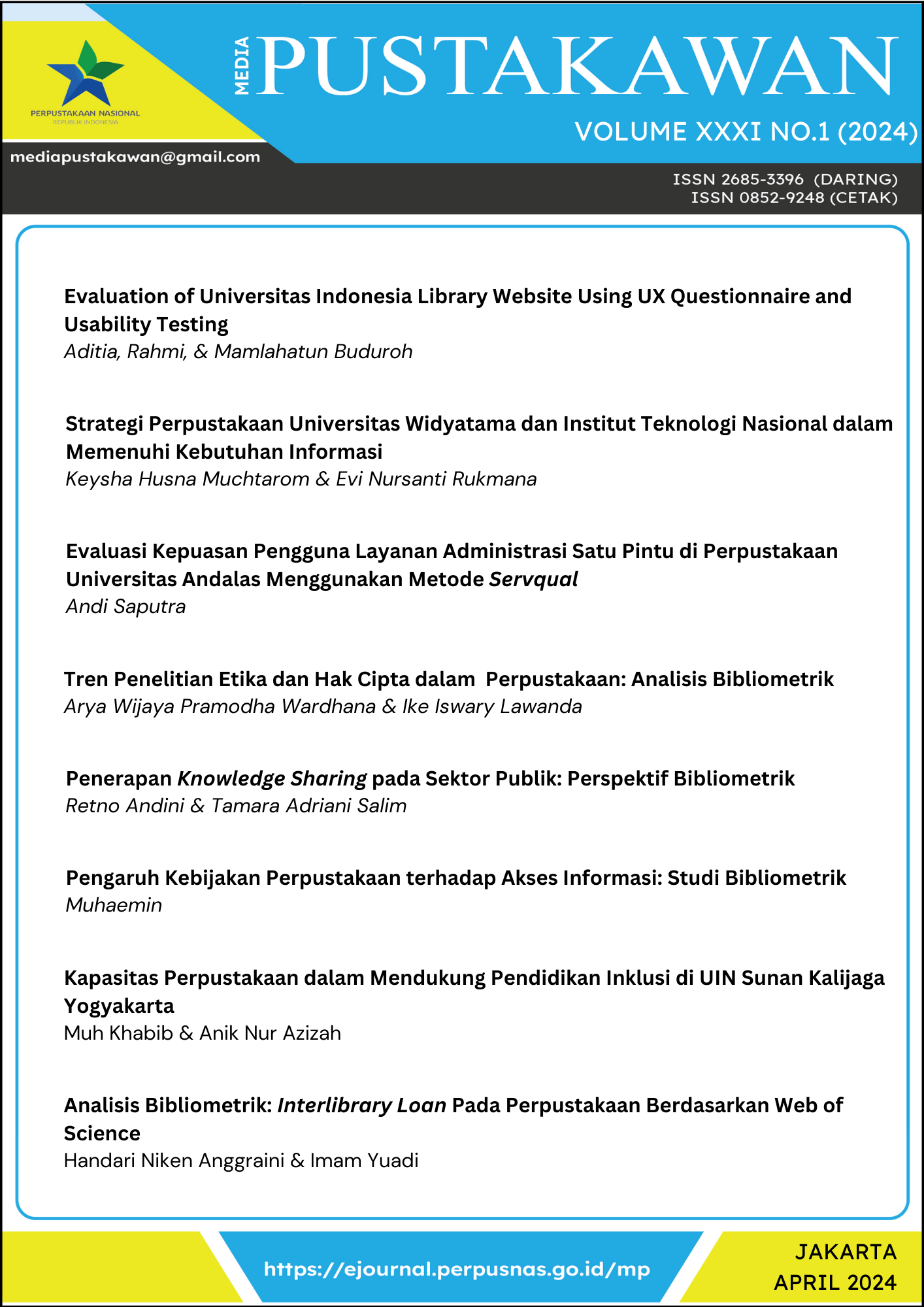Pengaruh Kebijakan Perpustakaan terhadap Akses Informasi
Studi Bibliometrik
DOI:
https://doi.org/10.37014/medpus.v31i1.5147Keywords:
library policy, information access, bibliometrics, biblioshinyAbstract
This study aims to analyze and map bibliometrically the results of research in the Dimensions database on the effect of library policy on inclusive, fair and quality information access for the community. The method used is a bibliometric study by analyzing 125 research sources from the Dimensions database in the 2014-2023 time span. The analysis was conducted using Biblioshiny to map authors, sources, countries and dominant keywords. There are three categories of information access, namely Open access, Close access, and Closed and open access. The countries that published the most research were the United States and South Africa. Some of the dominant keywords are public libraries and academic libraries. The results of this study show that library policies have an influence in providing access to information for the public. There are challenges in implementing policies that support equal access, especially for minority groups and people with disabilities. This research trend focuses on public and academic libraries as the frontline in providing access to information for people from all walks of life. In conclusion, this research emphasizes the importance of developing dynamic and responsive library policies to address structural inequalities, improve accessibility and bridge the digital divide in accessing information.References
A. Lubis, N. R. (2022). Informasi berbasis media sosial pada perpustakaan digital. Jurnal Pari, 8(1), 53–56. https://doi.org/10.15578/jp.v8i1.11517
Ajayi, N. A. (2003). Closed-access policy as a solution to library crime: perception and view of students. Libri, 53(3), 221–225. https://doi.org/10.1515/LIBR.2003.221
Álvarez, J. E., Rodríguez, G., & Valentín, A. (2019). Navigating murky waters between closed- and open-access content: The role of libraries and their institutional repositories. UPR Recinto De Mayagüez, 1–10. https://hdl.handle.net/20.500.11801/2527
Arum, A. P., & Marfianti, Y. (2021). Pengembangan perpustakaan digital untuk mempermudah akses informasi. Information Science and Library, 2(2), 92–100. https://doi.org/10.26623/jisl.v2i2.3290
Badan Pengembangan dan Pembinaan Bahasa. (2023). Kebijakan. Dalam Kamus Besar Bahasa Indonesia (KBBI). Retrieved from https://kbbi.kemdikbud.go.id/
Bakshi, M. & Verma, R. (2023). Trends in cause-related marketing (crm): Scientometrics analysis through prism of biblioshiny. International Journal of Professional Business Review, 8(4), 995. https://doi.org/10.26668/businessreview/2023.v8i4.995
Brook, F., Ellenwood, D., & Lazzaro, A. E. (2015). In pursuit of antiracist social justice: denaturalizing whiteness in the academic library. Library Trends, 64(2), 246–284. https://doi.org/10.1353/lib.2015.0048
Davlatov, S. (2022). The leading role of the librarian in providing library and information services to users. Infolib, 29(1), 30–35. https://doi.org/10.47267/2181-8207/2022/1-100
European Bank. (2019). Access to information policy. European Bank.
Joudrey, D. N., & Taylor, A. G. (2018). The organization of information (4th ed.). Libraries Unlimited.
Jun, W. (2020). A study on the current status and improvement of the digital divide among older people in Korea. International Journal of Environmental Research and Public Health, 17(11), 3917. https://doi.org/10.3390/ijerph17113917
Kassahun, K., & Nsala, C. (2017). The awareness of academic librarians towards open access resources to support reference services: A case of private institutions of higher learning in Gaborone, Botswana. Session S12 - Reference as Service and Place - Satellite Meeting: Reference and Information Services, 1–10. https://library.ifla.org/id/eprint/1964/
Khan, D., Ashar, M., & Yuvaraj, M. (2023). Do open access journals have a greater citation impact? A study of journals in library and information science. Collection and Curation, 42(1), 13–24. https://doi.org/10.1108/CC-03-2022-0010
Kinanti, K., Sulastari, I., & Yulianti, S. (2023). Kolaborasi perpustakaan umum dan tbm dalam penyediaan akses koleksi perpustakaan bagi masyarakat daerah terpencil. Media Pustakawan, 30(3), 295–309. https://doi.org/10.37014/medpus.v30i3.4988
Kumbier, A., & Starkey, J. (2016). Access is not problem solving: disability justice and libraries. Library Trends, 64(3), 468–491. https://doi.org/10.1353/lib.2016.0004
Labibah, L., & Marwiyah, M. (2018). Perpustakaan UIN Sunan Kalijaga sebagai research library: Study feasibility menuju world class university library. Al Maktabah, 17(1), 42–57. https://journal.uinjkt.ac.id/index.php/al-maktabah/article/view/11068
Mugwisi, T., Jiyane, G. V., & Fombad, M. C. (2018). Public libraries as facilitators of information services. Information Development, 34(1), 31–43. https://doi.org/10.1177/0266666916672718
Phukubje, J., & Ngoepe, M. (2016). Convenience and accessibility of library services to students with disabilities at the University of Limpopo in South Africa. Journal of Librarianship and Information Science, 49(2), 180–190. https://doi.org/10.1177/0961000616654959
Ramdhani, A., & Ramdhani, M. A. (2017). Konsep umum pelaksanaan kebijakan publik. Jurnal Publik, 11(1), 1–12. https://journal.uniga.ac.id/index.php/JPB/article/view/1
Rodin, R. (2021). Dasar-dasar organisasi informasi: Teori dan praktik pengorganisasian dokumen perpustakaan dan informasi. Lembaga Chakra Brahmana Lentera.
Sahidi. (2017). Peran kebijakan open access informasi dalam membangun komunikasi ilmiah di perpustakaan perguruan tinggi. Jupiter, XVI(1), 43–50. http://journal.unhas.ac.id/index.php/jupiter/article/download/4214/2407
Saputro, D. R. S., Prasetyo, H., Wibowo, A., Khairina, F., Sidiq, K., & Wibowo, G. N. A. (2023). Bibliometric analysis of neural basis expansion analysis for interpretable time series (n-beats) for research trend mapping. BAREKENG: Jurnal Ilmu Matematika Dan Terapan, 17(2), 1103–1112. https://doi.org/10.30598/barekengvol17iss2pp1103-1112
Schmitz, J. (n.d.). Open access vs. closed access. Publisso. https://www.publisso.de/en/advice/publishing-advice-faqs/open-access-vs-closed-access
Schöpfel, J., & Prost, H. (2013). Degrees of secrecy in an open environment. The case of electronic theses and dissertations. Essachess - Journal for Communication Studies, 6(2), 65–86. https://www.essachess.com/index.php/jcs/article/view/214
Silva, M. do S. T., Oliveira, V. M. de, & Correia, S. É. N. (2022). Scientific mapping in Scopus with Biblioshiny: A bibliometric analysis of organizational tensions. Contextus – Revista Contemporânea de Economia e Gestão, 20(5), 54–71. https://doi.org/10.19094/contextus.2022.72151
Wojturska, R. (2022). Diamond open access publishing in the library. In Edinburgh Open Research (pp. 1–13). https://doi.org/10.2218/eorc.2022.6953
Wulansari, A., Albab, M. U., Priatna, Y., & Subhan, A. (2021). Inovasi layanan perpustakaan di era pandemi covid-19 (best practice Perpustakaan Universitas Muhammadiyah Ponorogo). Publication Library and Information Science, 4(2), 44–60. https://doi.org/10.24269/pls.v4i2.3610
Yudhanto, S., & Nashihuddin, W. (2017). Upaya pustakawan dalam peningkatan kualitas jurnal dan mendukung gerakan open access journal di Indonesia. Pustakaloka, 9(2), 283–311. https://doi.org/10.21154/pustakaloka.v9i2.1090
Yusniah, Y., Nasution, K. A., & Lubis, S. R. (2023). Open open access sebagai media jaringan kerjasama perpustakaan perguruan tinggi. El-Mujtama: Jurnal Pengabdian Masyarakat, 3(1), 227–232. https://doi.org/10.47467/elmujtama.v3i1.2385
Zheng, X., Pan, L., Lu, B., & Jin, Y. (2022). Theme mining and quantitative evaluation of library policies. Journal of Computational Methods in Sciences and Engineering, 22(6), 2227–2241. https://doi.org/10.3233/JCM-226360
Downloads
Published
How to Cite
Issue
Section
License

This work is licensed under a Creative Commons Attribution-NonCommercial-ShareAlike 4.0 International License.








